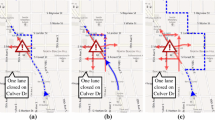Abstract
Automatic incident detection is becoming one of the core tools of urban traffic management, enabling more rapid identification and response to traffic incidents and congestion. Existing traffic detection infrastructure within urban areas (often installed for traffic signal optimization) provides urban traffic control systems with a near continuous stream of data on the state of traffic within the network. The creation of a simulation to replicate such a data stream therefore provides a facility for the development of accurate congestion detection and warning algorithms. This paper describes firstly the augmentation of a commercial traffic model to provide an urban traffic control simulation platform and secondly the development of a new incident detection system (RAID—Remote Automatic Incident Detection), with the facility to use the simulation platform as an integral part of the design and calibration process. A brief description of a practical implementation of RAID is included along with summary evaluation results.









Similar content being viewed by others
References
Department for Transport (1997). National Road Traffic Forecasts (Great Britain) 1997. TSO: London.
Freight Transport Association (2003). Roads—Congestion is the Real Toll, Press release 29th December 2003.
Royal Society for the Prevention of Accidents (2000). Road Safety Engineering Factsheet. Cost Effective Local Safety Schemes. Available at http://www.rospa.com/roadsafety/advice/highway/local_schemes.htm
Traffic Advisory Unit (1999). The ‘SCOOT’ urban traffic control system. Traffic Advisory Leaflet 7/99. Department for Transport: London.
Bretherton D, Bodger M and Baber N (2004). SCOOT—the future. Proceedings of the 12th International Conference on Road Transport Information and Control, IEE, UK, pp 301–306.
Kirkham R (1997). Making the most of SCATS. Traffic Technol Int, Annual Review, 32–34.
Abdel-Rahim A, Taylor WC and Bangia A (1998). The SCATS effect. Traffic Technol Int February/March: 57–60.
Cherrett TJ, McLeod F, Bell H and McDonald M (2002). Journey time estimation using single inductive loop detectors on non-signalised links. J Opl Res Soc 53: 610–619.
Palen J (2001). A watching brief. Traffic Technol Int October/November: 43–46.
Cherrett TJ, Bell HA and McDonald M (2000). Traffic management parameters from single inductive loop detectors. Transport Res Rec 1719: 112–120.
Wren A and Jones P (1996). ROMANSE—Road management system for Europe. Proceedings of the 8th International Conference on Road Traffic Monitoring and Control, IEE, UK, pp 23–27.
Cherrett T, Waterson B and McDonald M . Remote Automatic Incident Detection (RAID) using inductive loop detectors. Proceedings of the Institution of Civil Engineers: Transport, forthcoming 158(2).
Acknowledgements
We wish to acknowledge the help and support of the staff of the ROMANSE traffic control centre, Southampton, UK and Siemens Traffic Controls Ltd, UK for their cooperation in this research.
Author information
Authors and Affiliations
Corresponding author
Rights and permissions
About this article
Cite this article
Waterson, B., Cherrett, T. & McDonald, M. The use of simulation in the design of a road transport incident detection algorithm. J Oper Res Soc 56, 1250–1257 (2005). https://doi.org/10.1057/palgrave.jors.2601973
Received:
Accepted:
Published:
Issue Date:
DOI: https://doi.org/10.1057/palgrave.jors.2601973




